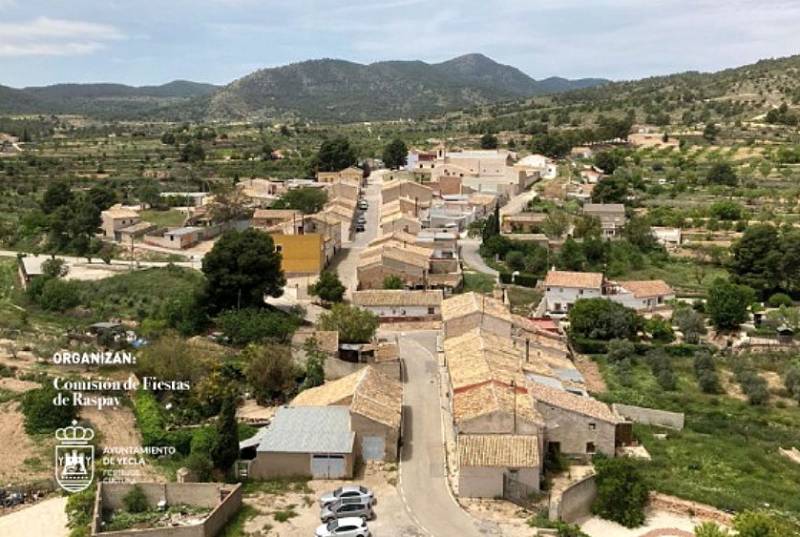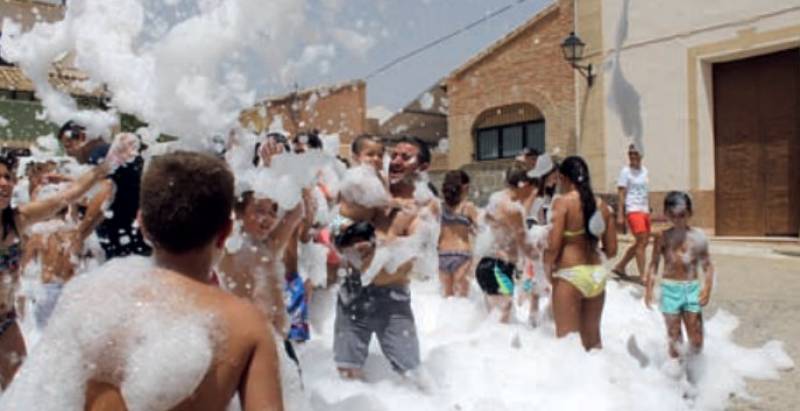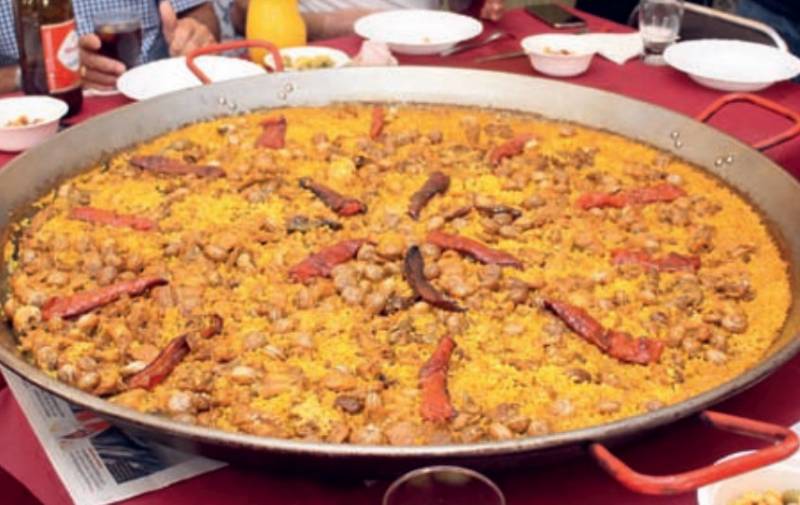- Region
- Vega baja
- Marina Alta
- Marina Baixa
- Alicante
- Baix Vinalopo
- Alto & Mitja Vinalopo
-
ALL TOWNS
- ALICANTE TOWNS
- Albatera
- Alfaz Del Pi
- Alicante City
- Alcoy
- Almoradi
- Benitatxell
- Bigastro
- Benferri
- Benidorm
- Calosa de Segura
- Calpe
- Catral
- Costa Blanca
- Cox
- Daya Vieja
- Denia
- Elche
- Elda
- Granja de Rocamora
- Guardamar del Segura
- Jacarilla
- Los Montesinos
- Orihuela
- Pedreguer
- Pilar de Horadada
- Playa Flamenca
- Quesada
- Rafal
- Redovan
- Rojales
- San Isidro
- Torrevieja
- Comunidad Valenciana
The village of Raspay in Yecla
A small rural community in the south of Yecla favoured by residents from northern Europe
 Raspay is a small village on the Yecla side of the boundary between the Region of Murcia and the province of Alicante, with an official population in 2022 of just 121. However, this represents an increase over the last few years, due principally to northern Europeans settling in the mountainous countryside just an hour’s drive from the city of Alicante and the Mediterranean coast.
Raspay is a small village on the Yecla side of the boundary between the Region of Murcia and the province of Alicante, with an official population in 2022 of just 121. However, this represents an increase over the last few years, due principally to northern Europeans settling in the mountainous countryside just an hour’s drive from the city of Alicante and the Mediterranean coast.
The village lies in the foothills of the Sierra de las Pansas, one of the areas of the Sierra del Carche, 23 kilometres south of Yecla, a similar distance east of Jumilla and 70 kilometres north of Murcia. Among the sites of interest in the nearby countryside are the cave of La Zurriera, a cave used as a hideout by bandit Jaime el Barbudo 200 years ago and the Fuente de las Pansas.
 The locals in this part of Spain speak both standard Castilian Spanish and Valenciano (in which the village is called Raspai), due to an influx of migrating farmers from the east in the 19th century.
The locals in this part of Spain speak both standard Castilian Spanish and Valenciano (in which the village is called Raspai), due to an influx of migrating farmers from the east in the 19th century.
The first records of the village date back to 1855, when the first priest was Antonio Ibáñez Galiano, and in the second half of the 20th century the population declined before the arrival of foreign residents after 2014.
Fiestas
 The local fiestas are held every year in late June and/or early July in honour of the Sagrado Corazón de Jesús and the Dulce Corazón de María. A procession takes place on the Sunday of the patrons and the three days are filled with music, games, conviviality and plenty to eat as the population of the village temporarily trebles due to visitors!
The local fiestas are held every year in late June and/or early July in honour of the Sagrado Corazón de Jesús and the Dulce Corazón de María. A procession takes place on the Sunday of the patrons and the three days are filled with music, games, conviviality and plenty to eat as the population of the village temporarily trebles due to visitors!
In 2023 so great was the interest in the fiestas among northern European residents and visitors that the programme was published in English, suggesting the emergence of a trilingual community!
If visiting Yecla don’t forget to make sure one of your first ports of call is the tourist office (Plaza Mayor, 1, telephone 968 754104, email turismo@yecla.es).
For more local events, news and visiting information go to the home page of Yecla Today.
staff.inc.ali
Oficina de Turismo de Yecla
In early 2025, due to renovation work at the usual office, the service is located on the other side of the Plaza Mayor at Calle Epifanio Ibáñez nº 2 (click for map).
 Yecla is a large municipality in the north of the Region of Murcia, home to just under 35,000 people, and these days is best known for its wines, which enjoy Denomination of Origin status, and its furniture production, which has its origins in the abundance of pine trees on the mountainsides and the high plateaux.
Yecla is a large municipality in the north of the Region of Murcia, home to just under 35,000 people, and these days is best known for its wines, which enjoy Denomination of Origin status, and its furniture production, which has its origins in the abundance of pine trees on the mountainsides and the high plateaux.
 While visitors in the 21st century may be attracted primarily by wine tourism, the town (or city, as it was proclaimed in 1878) also has a wide historical, cultural and natural heritage, and an identity quite different from the coastal areas of the Region of Murcia. For this reason it is often grouped together with its neighbour and fellow wine-producing area Jumilla as part of the Altiplano area.
While visitors in the 21st century may be attracted primarily by wine tourism, the town (or city, as it was proclaimed in 1878) also has a wide historical, cultural and natural heritage, and an identity quite different from the coastal areas of the Region of Murcia. For this reason it is often grouped together with its neighbour and fellow wine-producing area Jumilla as part of the Altiplano area.
Yecla borders with Castilla-La Mancha and the Region of Valencia and is closer to Alicante coastal areas than much of Murcia. These visitors come to see the historic old town itself - an atmospheric and interesting place, crammed full of history - the natural beauty of Monte Arabí, with stunning views for those who enjoy the outdoors, the gastonomy and of course the wine route.
 Yecla boasts cave paintings from 10,000 years ago in Monte Arabí, a Bronze Age settlement at El Arabilejo, Iberian remains in El Pulpillo and a Roman administrative centre at Los Torrejones as well as the remnants of the 11th century Moorish castle on the hill behind the town. More modern (and complete) testimony to the past are the buildings in the town centre, which include the grandiose Basílica de la Purísima, with its striking blue dome, the archaeological museum and the attractive Plaza Mayor, where the 16th century Town Hall stands alongside the Renaissance Casa de los Alarcos, the clock tower and the old grain store.
Yecla boasts cave paintings from 10,000 years ago in Monte Arabí, a Bronze Age settlement at El Arabilejo, Iberian remains in El Pulpillo and a Roman administrative centre at Los Torrejones as well as the remnants of the 11th century Moorish castle on the hill behind the town. More modern (and complete) testimony to the past are the buildings in the town centre, which include the grandiose Basílica de la Purísima, with its striking blue dome, the archaeological museum and the attractive Plaza Mayor, where the 16th century Town Hall stands alongside the Renaissance Casa de los Alarcos, the clock tower and the old grain store.
 The tourist office holds a full selection of leaflets, maps, pre-planned routes, accommodation and restaurant options and information about visiting Yecla for both individuals and groups.
The tourist office holds a full selection of leaflets, maps, pre-planned routes, accommodation and restaurant options and information about visiting Yecla for both individuals and groups.
There is parking close to the tourist office, although those driving to Yecla for the first time are advised to park in Calle Perales.
For further information go to the home page of Yecla Today.
Opening hours:
Tuesday to Friday 8.00 to 15.00
Saturdays 10.30 to 14.00 and 17.00 to 19.30.
Public holidays 10.30 to 14.00
Click for map, Yecla tourist office


